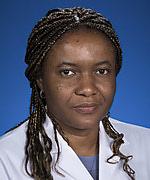Obesity, Age at Menopause Play Integral Role in Heart Failure Risk Among Women
Data from an analysis of the ARIC study detail the increased risk of heart failure associated with obesity and increased waist circumference based on the age a woman enters menopause.
Imo Ebong, MD, MS

Data from a new study is providing insight into the elevated risk of heart failure associated with increased BMI and waist circumference among women as they enter menopause.
Funded by the National Heart, Lung, and Blood Institute of the National Institutes of Health, results of the 4500-person indicate obesity was associated with increased risk of heart failure across all age groups, but this risk was most apparent among women with obesity who entered menopause at age of 55 or later.
“There is a gap in knowledge about the possible influence of late menopause – occurring at age 55 or older – on the incidence of heart failure,” said lead investigator Imo A. Ebong, MD, MS, an associate professor of medicine in the division of cardiovascular medicine at the University of California Davis, in a statement. “We know that obesity increases the risk of developing heart failure, and the onset of menopause is associated with increased body fatness. In our study, we investigated if and how obesity affects the relationship between menopausal age and the future risk of developing heart failure.”
Citing the aforementioned knowledge gap, Ebong and a team of colleagues designed their study with the intent of assessing a potential presence of heterogeneity by obesity on the relationship between menopausal age and heart failure incidence in postmenopausal women using data from the Atherosclerosis Risk in Communities Study (ARIC). An observational epidemiologic study launched in 1987 and conducted in communities in North Carolina, Mississippi, Minnesota, and Maryland, the ARIC study provided investigators with data
Using ARIC Visit 4 as the baseline for their analysis, the investigators’ cohort for the current study included 5539 women with natural or surgical menopause at the time of visit 4, which occurred from 1996-1998. From this cohort Investigators excluded Black women from Minnesota or Maryland centers because of small numbers, those who were not of Black or White race, those with missing information on menopausal age, those who had undergone hysterectomy without bilateral oophorectomy before 55 years of age, those with missing information on BMI or waist circumference, women who were underweight, those missing information on heart failure incidence, and those with prevalent heart failure at visit 4.
The final sample size of the investigators’ analyses was 4441 postmenopausal women, with 3636 women who experienced natural menopause and 808 with surgical menopause. This cohort had a mean age of 63.5±5.5 years, a mean follow-up of 16.5 years, and 903 incident heart failure events occur during the follow-up period.
Investigators assessed hazard ratios of incident heart failure with menopausal age using Cox proportional hazards models, with plans to assess effect modification by obesity and adjusting for known heart failure risk factors. For the purpose of analysis, women were categorized according to menopausal age, with groups defined as younger than 45 years, 45-49 years, 50-54 years, and 55 years of age or older.
Upon analysis, results indicated the incidence rates of heart failure were 15.6, 12.1, 10.3, and 10.7 per 1000 person-years among women who entered menopause before the age of 45, 45-49 years, 50-54 years, and at the age of 55 years or older, respectively. Investigators pointed out the incidence rates of heart failure were greatest among women with generalized or central obesity who had also experienced menopause before the age of 45 years of age, with rates of 21.3 and 16.3 per 1000 person-years, respectively, but the attributable risk of generalized obesity, overweight, and central obesity for heart failure incidence was greatest among women who experienced menopause at the age of 55 years or later, with rates of 11.09, 4.56, and 7.38 per 1000 person-years, respectively.
Further analysis indicated the adjusted HRs for incident heart failure with each SD increase in BMI were 1.39 (95% CI, 1.05–1.84), 1.33 (95% CI, 1.06–1.67), 0.98 (95% CI, 0.73–1.31), and 2.02 (95% CI, 1.41–2.89) for women with menopausal age less than 45 years, 45-49 years, 50-54 years, and 55 or more years, respectively. Additionally, results suggested the adjusted HRs for incident heart failure associated with each SD increase in waist circumference were 1.31 (95% CI, 0.98–1.75), 1.18 (95% CI, 0.92–1.52), 1.00 (95% CI, 0.75–1.32), and 2.93 (95% CI, 1.85–4.65) for women with menopausal age less than 45 years, 45-49 years, 50-54 years, and at 55 years or later, respectively.
“A woman’s age when she enters menopause is an important factor, and women should share this information with their physicians to guide in estimating their risk of developing heart failure,” Ebong added. “Women with early menopause should be informed of their increased risk and counseled to adopt healthy lifestyle and behavioral changes. Women with late menopause should be particularly counseled to maintain a healthy body weight and prevent obesity to decrease their risk of future heart failure.”
This study, “Relationship Between Age at Menopause, Obesity, and Incident Heart Failure: The Atherosclerosis Risk in Communities Study,” was published in the Journal of the American Heart Association.